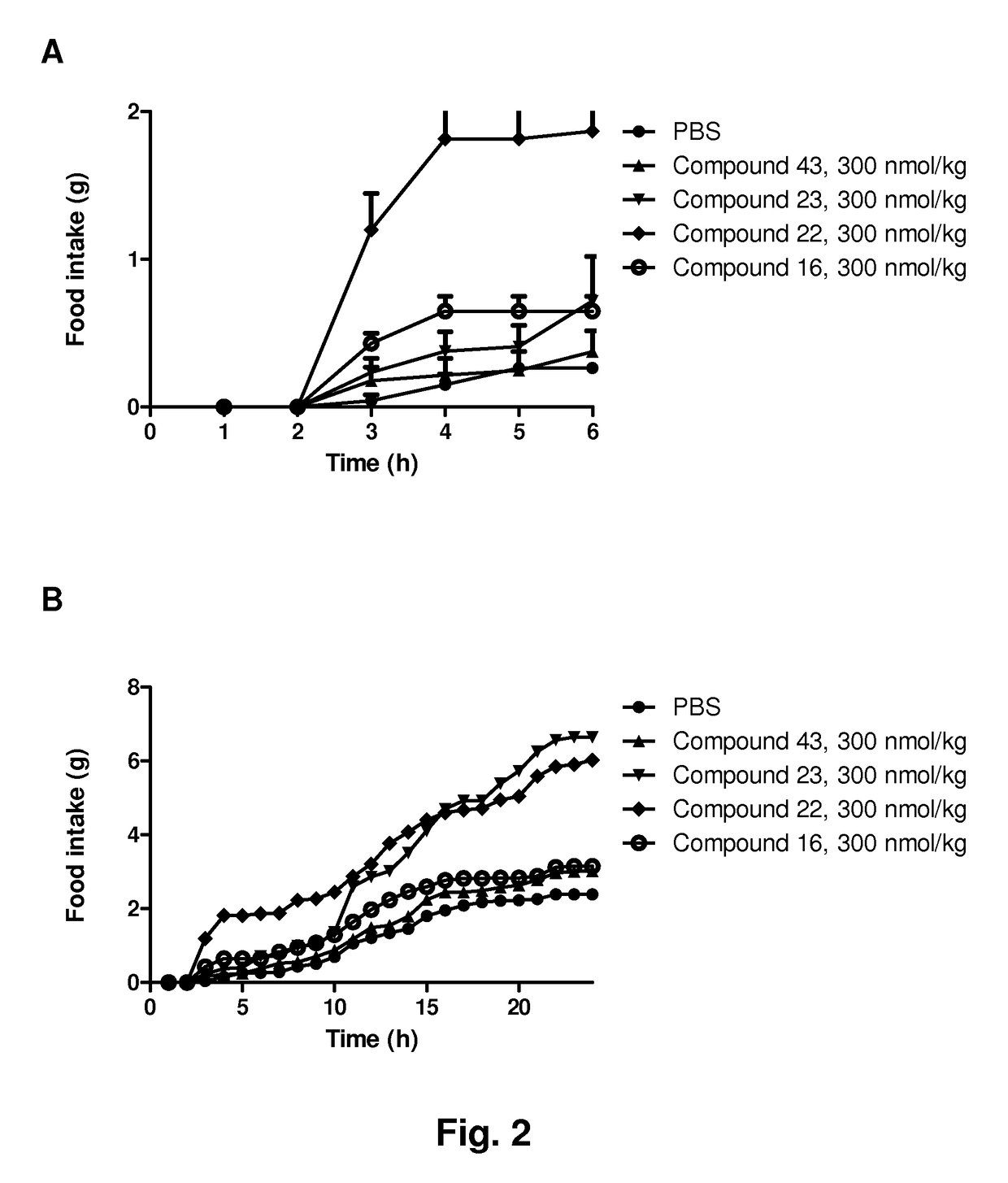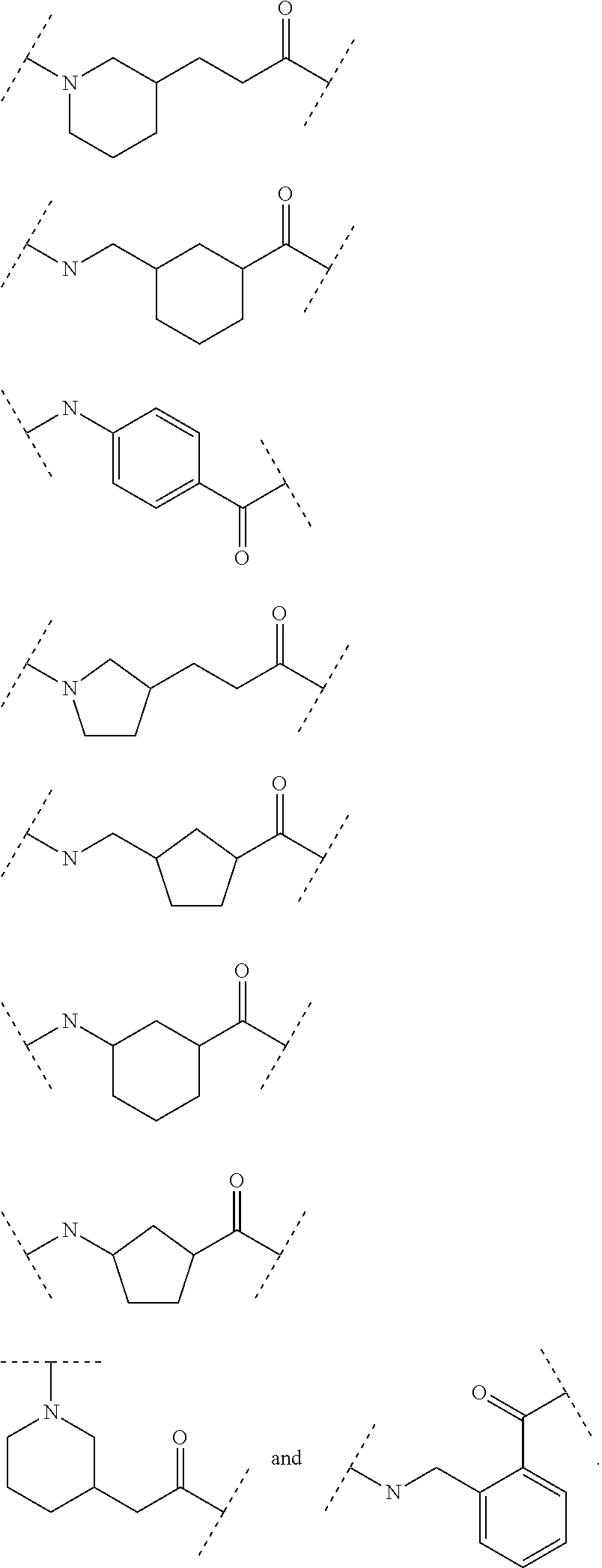Ghrelin analogues
a technology of ghrelin and analogues, applied in the field of ghrelin analogues, can solve the problems of inability to perform everyday tasks, inability to effectively treat cachexia, and extremely weak individuals affected by the syndrome, and achieves the effects of improving the quality of li
- Summary
- Abstract
- Description
- Claims
- Application Information
AI Technical Summary
Benefits of technology
Problems solved by technology
Method used
Image
Examples
example 1
Synthesis of H-PS-S(O-octyl)-FLSPEHQRVQQRKESKKPPAKLQPR-OH (Compound No. 19) (SEQ ID NO: 21)
[0297]TentaGel S PHB Fmoc-Arg(Pbf) resin (1.30 g; 0.326 mmol; Rapp Polymere) was treated with 20% piperidine in NEP for initial deprotection. A temperature increase to approx. 40° C. within 30 seconds was observed. The reaction vessel was drained and a second portion of 20% piperidine in NEP was added. This round of deprotection took place for 3 minutes, keeping the temperature between 70 and 75° C. The resin was then subjected to repeated introduction of Fmoc-amino acid by COMU / DIPEA, and elimination of Fmoc by 20% piperidine in NEP.
Coupling Step:
[0298]the mixture was heated to 75° C. and then allowed to cool down. This heating and cooling cycle was repeated over a period of 5 minutes. During the coupling, nitrogen was bubbled through the reaction vessel.
Fmoc Deprotection Step:
[0299]20% piperidine in NEP was added for initial deprotection. A temperature increase to approx. 40° C. within 30 se...
example 2
Synthesis of H-PS-S(O-octanoyl)-FLSPEHQRVQQRKESKKPPAKLQPR-OH (Compound No. 5) (SEQ ID NO: 7)
[0303]TentaGel S PHB Fmoc-Arg(Pbf) resin (3.759 g, divided into three portions which were run in parallel; 0.940 mmol; Rapp Polymere) was treated with 20% piperidine in NEP for initial deprotection. A temperature increase to approx. 40° C. within 30 seconds was observed. The reaction vessel was drained and a second portion of 20% piperidine in NEP was added. This round of deprotection took place for 3 minutes, keeping the temperature between 70 and 75° C. The resin was then subjected to repeated introduction of Fmoc-amino acid by COMU / DIPEA, and elimination of Fmoc by 20% piperidine in NEP.
Coupling Step:
[0304]the mixture was heated to 75° C. and then allowed to cool down. This heating and cooling cycle was repeated over a period of 5 minutes. During the coupling, nitrogen was bubbled through the reaction vessel.
Fmoc Deprotection Step:
[0305]20% piperidine in NEP was added for initial deprotect...
example 3
Ghrelin Receptor Functional Assay
[0308]To test activation of the ghrelin receptor, stable cell lines expressing the human ghrelin receptor were produced. In brief, HEK293 cells were used for transfection of the cDNA for human ghrelin receptor cloned into the transfection plasmid pIRESneo2dNGFR. More specifically, the cDNA encoding the human growth hormone secretagogue receptor type 1a (GHSR1a; ghrelin receptor) was cloned from the cDNA clone AY429112 (accession no. AY429112.1; GI:38016896) (SEQ ID NO: 6). The DNA encoding the ghrelin receptor was amplified by PCR using primers also encoding terminal restriction sites for subcloning. The ghrelin receptor was subcloned into a mammalian expression vector containing a neomycin (G418) resistance marker. The fidelity of the DNA encoding the receptor was confirmed by DNA sequencing. HEK293 cells were used for transfection of the ghrelin receptor expression plasmid. The cells were grown according to standard protocol in growth medium and tr...
PUM
| Property | Measurement | Unit |
|---|---|---|
| time | aaaaa | aaaaa |
| time | aaaaa | aaaaa |
| temperature | aaaaa | aaaaa |
Abstract
Description
Claims
Application Information
 Login to View More
Login to View More - R&D
- Intellectual Property
- Life Sciences
- Materials
- Tech Scout
- Unparalleled Data Quality
- Higher Quality Content
- 60% Fewer Hallucinations
Browse by: Latest US Patents, China's latest patents, Technical Efficacy Thesaurus, Application Domain, Technology Topic, Popular Technical Reports.
© 2025 PatSnap. All rights reserved.Legal|Privacy policy|Modern Slavery Act Transparency Statement|Sitemap|About US| Contact US: help@patsnap.com



